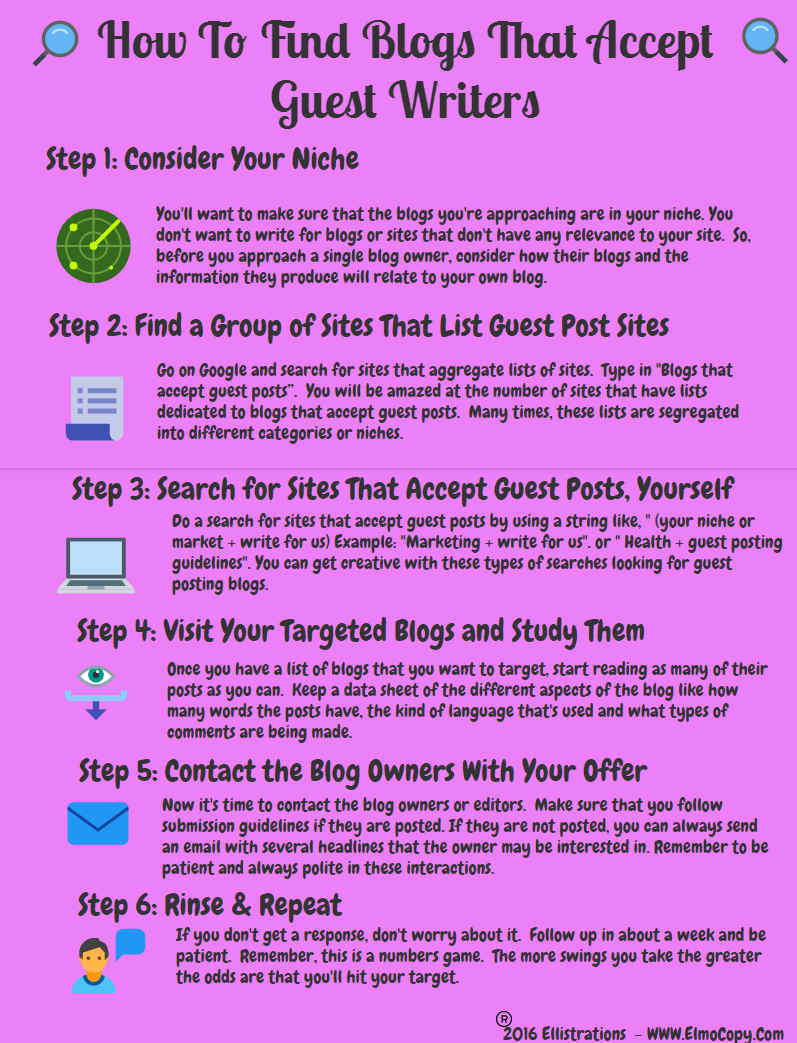One of the best ways you can quickly get targeted traffic and people of influence linking to your site is by guest posting.
Even though you’re guest posting on someone else’s blog you’ll still need to make sure that you put just as much care into your guest posts as you do into your own blogs posts.
The reason for this is simple: you are building your reputation ―not only with the audience but also with the blog owner.
This is an asset that can serve you for years to come.
In this post, I’m going to show you how to get other bloggers to accept you as a guest writer, and then how to submit a proposal to them that will enable you to write for their blog.
 Getting Started with Guest Posting
Getting Started with Guest Posting
You’ll want to keep track of the sites that you’re targeting in your niche.
The best way to do that is either with a Microsoft Word document using a table grid, or an easier way would be by using an Excel spreadsheet.
You’re going to want to keep spreadsheets on the different sites, their URL’s, posting guidelines, how many words they generally use in their posts, etc.
How to Target Blogs to Write Guest Posts For
Many blogs and bloggers don’t accept guest posters. And while some say they do, they still make it darn hard to contact them for some reason.
As you’ve already figured out, if the blog or the blogger is an online authority, it will probably be harder to approach them and get them to accept you as a guest poster.
I’m not saying that it’ll be impossible, but it won’t be easy either.
However, there are all sorts of blogs that do want guest posters, and if you know how to find them, you have a pretty good shot of getting your post on their blog.
So, how do you find blogs and sites to write for?
 Finding Blogs to Write For
Finding Blogs to Write For
It’s really not hard to find them if you know how. The easiest way is to Google this phrase:
“Blogs that accept guest posts”
Here’s a list of the sites that popped up when I hit the “Enter” key after submitting that phrase:
Guest Post Tracker – This is a site that has a list of 928 blogs that allow guest posts. This site also provides a service that helps you track and approach those blogs.
Of course, you’ll have to at least give them a name and an email address to get to use some of the services and there are also upgrades that you have to pay for.
Peter Sandeen’s Site – Peter Sandeen is an online marketing guru, and he’s compiled a list of 140 sites that he thinks are pretty sweet for guest bloggers.
He’s managed to put in his 2 centavos on why he thinks these sites are great for guest posting. This means that he’s taken the time to check out and evaluate these sites.
The Shout Me Loud Blog – This resource has about 40 blogs that are about blogging and accept guest bloggers. This is a great site for those of you that are bloggers and like writing about it.
The Web Marketing Saga Blog – This blog states, “Get the Most Out Of Your Blog” and it certainly tries to live up to its theme.
The owner of this blog, Andre Dubois, lays out an organized list of 386 blogs that he has deemed as worthy of approaching.
Easy M6 – This site has an ultimate list to guest blogging, but I would probably say that there are a lot of sites that say they have an “ultimate guide”. (Just take that with a grain of salt.)
Another great way to find blogs to write posts for is to use a search engine and keywords and phrases. (These are also known as “search strings”.)
Here’s a list of some of the phrases that you can use:
“Business Blog + write for us”
“Marketing + write for us”
“Info Marketing + write for us”
“Motivation + write for us”
“health + write for us”
So, whatever keywords that’ll be relevant to your niche will be the keywords or phrases you’ll type in.
For example, if you’re in the golfing niche, you can type in:
“Golfing + write for us” or “Golfing + guest post” or even “Guest Posting Guidelines for Golfing Blogs”
Usually when you use the “Guest Posting Guidelines” you’ll be treated to a list of pages that look similar to this:
There are quite a few ways to find guest posting sites and you can play around with Google or another search engine of choice and try different keyword strings or phrases.
There are other resources that you can try that will help you find blogs in your niche. One of them was the Blog Search Engine (http://www.blogsearchengine.org).
I tried this resource out and used the string format I tried before.
“Golf + Guest Post” turned up quite a few sites that were different from Google’s.
I can’t say how long the Blog Search Engine will be around, hopefully it’s one of those Google based engines that has the search engine giant’s blessing; in the past it seems that there are quite a few blog resources that Google didn’t like and aren’t around anymore.
 Bearing Down On Your Most Promising Blogs
Bearing Down On Your Most Promising Blogs
Once you’ve got a good, solid list of blogs that you can start approaching, you will need to take a look at their status, because there are a lot of blogs out there that aren’t worth targeting.
You’re going to need blogs that are getting good traffic. Even though the backlinks are nice to get from a higher authority site, the traffic you’ll get from those blogs will be so much more important and better for your mission.
 Looking At Traffic Numbers
Looking At Traffic Numbers
One of the things that you can easily do, is look at a blog’s traffic numbers. However, I want to offer a word of caution.
Looking at a site’s numbers can be rather deceptive.
You can have a load of people going to a site, but if they’re merely going there to look at it for a few seconds and then leave, then those numbers aren’t going to mean a heck of a lot.
Just recently, there was a site that offered free analysis of your sites SEO, and as you waited of the information to process, you had an opportunity to play a simple little game. As it turned out, a lot of people liked playing the game and were returning to play it instead of using the site’s services.
So sure, there were a bunch of people going back to the site, but they were only going there to have fun with a simple game.
I’m sure that the site owner was thrilled with the returning traffic numbers until he figured out that people were going back to merely play the game on his site.
A Very Easy Way to Check a Site’s Traffic
A super easy way to check out a blog or websites traffic, is to use an online site that has become an industry standard ― Alexa (www.alexa.com). Alexa will give you an overview of how popular a site is as well as if traffic has increased or decreased on a particular site of the last couple of years.
Another site that you can use to check traffic and other data is Similar Web. (www.similarweb.com) Similar Web is very much like Alexa but it offers you tips on how you can improve your rankings underneath each section of the data.
A Word of Caution about Traffic Sites
If you get curious and decide to check your blog’s or site’s traffic out on each of these data sites ―then expect to be disappointed.
These sites only display the significant websites and blogs that are online. So, if you decide to check out your site and don’t see any data listed you may get discouraged.
You need to focus on creating an audience that is addicted to your site and what it has to offer.
I know of an online businessman that was making great money selling information products. His rankings on sites like Alexa were non-existent. However, he sold loads of products through different sites like eBay, Amazon and his own sales pages.
He was doing fine.
The main idea for most bloggers is to make money eventually. And even when you’re making money, you still have to watch all of your expenses.
A Lesson from the Tank
If you’ve ever watched the TV show Shark Tank, you’ll see people that have sold millions of dollars in products that they have created.
Sounds impressive, right?
Yet many times these budding entrepreneurs aren’t taking a dime of it home. They either took out too many loans, or the products they’re selling cost way more to make than what they’re able to sell them for.
What good is all of that work if you’re not taking any of that money home?
As I said before, keep everything in perspective.
If you check your sites rankings and they aren’t what you’d like them to be, don’t worry about it too much.
If you’re working your blogging strategy diligently, then eventually all of your hard work will pay off.
Better Ways of Determining a Site or Blog’s Traffic
A while back I wrote a post on how to investigate different niches that you could build different businesses in.
What I pointed out in that post was the fact that you could find out the popularity of a subject or niche by looking at Amazon’s best seller list, and checking out the books that were popular in the different subject nonfiction categories.
If you find a couple of books on Amazon that have a lot of comments on them, then you’ll have a good idea of whether your subject matter or niche is a good idea.
If a bunch of people took the trouble and time to buy a book, and then went back onto Amazon’s site to leave a comment, chances are it was a pretty good book and subject, right?
It’s the same idea with a blog. If a crap-load of people took the time and trouble to go onto someone’s blog and write comments, chances are the blog is a pretty good one.
This is better than just checking traffic because it indicates that people aren’t just visiting the blog ― they are also ENGAGED!
Engagement is more important than traffic any day. Engagement means that there is a tribe, a herd, a committed group of people that will return again and again to your site.
They like what you’re saying and will buy into your offer, probably without reservation.
So when you start checking out the blogs in your niche to write for, take a good look at the comments section.
Usually, a lot of comments means there’s quite a bit of traffic to the blog or site anyway, because out of every 200 people to a site, there is usually one comment.
Another thing you can ascertain about studying a blogs comments is how the comments are maintained.
Blogs get a lot of spammers to their sites that post their stupid spam comments and then leave a link. If a blog is run haphazardly then you’ll see the spam comments left.
This usually means that the blogger isn’t really paying attention, and therefore the blog is probably not a good one to target for guest posting.
Advanced Comment Tactic
If the blog looks like a good one with great comments and solid traffic, then you may want to take notes on what the audience is really talking about. Once you start writing your guest blog posts, you’ll have a good idea as to what problems and aspirations the readers are concerned with.
Then you can easily write posts that will address the needs of the blog’s audience.
Check for Author Biographies
Another thing that you’ll definitely want to check for on your target blogs is author biographies. If you don’t see a place on the blog that has a space dedicated to the guest posters, then you may want to look elsewhere.
At the very least, the guest post section should contain the following:
- The author bio should have the bio section on the same page as the post, if possible. Very few people will click through to a link on another page to read a bio on the author.
- You should have enough room to write several sentences about yourself so that you could entice readers to visit your site.
- You need to be able to link to your site and not just a social media page or a LinkedIn account. Your link should also have the option to embed keywords or a descriptive link to your site.
Approaching Guest Posting Blogs
Once you’ve targeted the different blogs that you want to write for, now it’s time to approach them with your offer.
For some weird reason, people choke at this point.
Whether it’s because they hate rejection or they can’t stand the process, they just won’t go through with it.
There are a couple of ways you can handle the fear or anxiety about this problem.
First, let me wipe any fear you have about approaching bloggers under the table. Most of the professional people you meet on the Internet are really nice. Many times, they’ll go out of their way to help you get started if they can.
So, if you email them your offer to write for their blog, the absolute worst thing that will happen is they will politely say, “No thanks.”
I’ve received a bunch of those types of responses in the past and I can tell you that the people I approached were always very polite and cordial.
Did I like getting a response like that? Heck no.
Did it stop me from approaching more blog owners? Heck no.
As a matter of fact, I make it a point to send out 10 more emails for every “no” I receive. I look at people telling me “no” as if it were fuel to market my offer to even more people!
See how that can work for you?
Another good way to handle the rejection is to think of it as a connection. If Seth Godin sends you a polite email back saying he isn’t interested in having you write a post for his blog, then he’s at least looked at and responded to your offer.
That means you can write a nice thank you back to Seth and he may remember you later on. He may even go to your site and check you out.
(By the way, Seth Godin writes all of his own blog posts, so don’t bother him. And if you do send him an offer to write for his blog, don’t mention my name because he doesn’t want to be bothered.)
Just because a blog owner or editor has rejected your post, that doesn’t mean that he will never let you write for him. What it usually means is that the offer you’re making isn’t what he or she is looking for at this moment.
Also, if you are consistently blogging, you will probably get better at your craft and therefore be able to approach bloggers much more professionally and confidently as time goes on.
A Way to Overcome Your Fear of Pitching Posts
If you’re really paranoid of sending out guest posting pitches, then here’s a couple of ways to get your feet wet and help you get started.
If you have any friends that have sites or blogs, try pitching them first. Just make sure that if their blog isn’t in your niche, just write for them and don’t request a link to your site. Remember, you want relevant links to your blog.
You can also target lesser known blogs that are dying for more content. Just make sure that if you give them a link back to your site, that the blog isn’t one that violates search engine rules and is relevant to your blog’s content or mission.
The Easiest Way to Approach a Blog Owner
One of the first steps you should take when trying to approach blog owners is to find out what his best posts were. In other words, you want to find out which posts were liked, shared and commented on the most.
The reason why you’ll want to do this is so that you can write a post that addresses the blogs most important issues and therefore be more compatible with the blog’s content.
Many times the easiest way to find out what the most popular posts were is to go to the blog and look at the popular post section on the right side of the blog. It usually looks something like this:
Once you find this section you’ll need to read at least 5 of these posts to get a good idea of what the content is like.
You will need to take these factors into consideration:
Voice ―What type of language are they using? Are they using slang that college aged people would use? Are they using an academic tone?
Length ―How long are the posts? You don’t want to send a 5000 word post to a blog that only uses 600 word posts only.
Headline Length ― How many characters do the headlines have? Count the characters in about 6 or 7 of the posts and then divide by the number of posts you used headlines from. What was the average number of characters?
Formatting ―Are they using subheads? Are the blog posts written in block paragraphs with indents? Take note of any type of formatting that they are using and try to imitate it in your guest posts.
Guest Posters Biographical Information ―Look at how the biographical information for the guest posters is written. You’ll want to make sure you send your information in the same way.
Gathering intel on the blogs you’re targeting is very important. You need to gather as much information as you can and take notes on the blog and its posts as possible.
Writing material that reflects the blog will speak volumes to the blog gatekeeper or owner, and possibly get you inside the guest posting door.
Two Options to Contacting Blog Owners
At this point you can take one of two paths.
You could either contact the blog owner with an offer to write a post for their blog by email, or you could go ahead and write an entire post for their blog using the information you gathered from studying their site.
If you’re going to pitch them by email, here’s the way to do it:
In the subject window of your email, let them know why you’re contacting them.
SUBJECT: Guest posting for your blog (Name the blog. If you know the name of the editor or owner and can place it in the subject area, do so. )
Hi, (Name of owner/gatekeeper)
I’ve been a big fan of your site for quite some time now, and I’d like to write a guest post for your blog.
I’ve done quite a bit of research on the most popular posts your blog has had published as well as what your readers are really interested in.
Here are some ideas I came up with that I think will be of interest to your readers:
(List about 3 or 4 headlines here, each on a separate line.)
Headline
Headline
Headline
I’ve already written quite a few posts for other blogs and if you’d like to check them out, here are a few links that I’m sure you’d be interested in:
Link
Link
Link
(If you don’t have too many posts online yet, skip the last part and go straight to the call to action.)
I’m sure you have a post or two that needs to be written waiting in the wings, please contact me as soon as possible and I’ll get started on another great post for your excellent blog.
Thank you so much for your time.
Sincerely,
(Your name)
(Your blog or website address if you have one)
Of course, you can rewrite this email to your suiting, but make it short and polite. Most online entrepreneurs are very busy and won’t have time to engage you at length.
 What to do if you don’t Hear Back from Them
What to do if you don’t Hear Back from Them
If you don’t hear back from the blog owner, then give it a week or so and send a second email to them that says something like this:
Dear (Name of blog owner if you have it.)
I sent you an email with a proposal to write a post for your blog on it.
I was just checking to see if you had a chance to read it yet. No hurry or anything like that just wanted to touch bases with you to see if you had an opportunity to read and consider it.
Looking forward to hearing from you, and thanks again for your time.
Sincerely,
(Your name and web address)
If you don’t hear back from them again, send them another email in a week or so.
 What to do if they Decline Your Offer
What to do if they Decline Your Offer
If they tell you, “No thanks” send them another short and polite email that says something like this:
Dear (Name of blog owner if you have it.)
Thanks so much for considering my proposal. I would still love to write a post for your blog someday, so please keep me in mind. I may send you another proposal in the future, if you don’t mind.
Thanks so much for your time and consideration.
Sincerely,
(Your name and web address)
What to do if they have Submission Guidelines
If the blog owners and editors have posted guidelines for blog post submissions, then follow those guidelines exactly as they have them posted and submit your work.
Usually, it takes a blog owner a while to get back with you even if they’re going to use your post, so be patient!
You can always follow up with them a week or two with a short, polite email asking them if they have received your post.
Remember, always be polite and thank them whenever you contact them.
 What to do If You Get Rejected
What to do If You Get Rejected
Submitting posts for a popular blog is a challenging task. You will get rejected at some point, because that is the nature of this business.
However, the rejection rate is far less than traditional publishing was before the Internet came along.
So my advice to you is to keep at it and never take it personally. There may be half a dozen reasons why a blog owner does not want to use your post at this time and none of it may be due to whether or not he or she liked your post.
What to Do With Rejected Blog Posts
If you happen to write a decent post and nobody wants to use it, then you have a golden opportunity.
You can use that post to promote your business; you can use it on your blog, or you can use it on a site like LinkedIn, Quora, or on a social media channel of your choice.
If you decide to use it on a site like LinkedIn, you won’t have to worry about duplicate content issues on your own site and therefore you can probably post it on a couple sites as well.
Another thing you can do with your post is go to lesser known blogs and pitch them as well.
There are bazillions of blogs and blog owners out there, and they are dying for content. As long as they’re in your niche, and a half way decent site, then there’s no reason why they wouldn’t probably give you a shot.
 Now it’s Time for You to Go Out There and Nail It!!!
Now it’s Time for You to Go Out There and Nail It!!!
You have all the information you need to go out into the blogging world and start pitching your proposals and posts to blogs.
Don’t forget that the more swings you take, the more chances you’ll have for success in this business.
To your continued success!
Agree? Disagree? Have anything interesting to say about this post?
Please leave your comments below!






Thanks for sharing good blog post about guest blogging, I tried all those steps and its working …. I always look your website for new update. Thanks again!
Jina, thank you so much for your input. I’ll be guest blogging on several sites this week. I’ll try to keep you posted on my progress. God Bless!